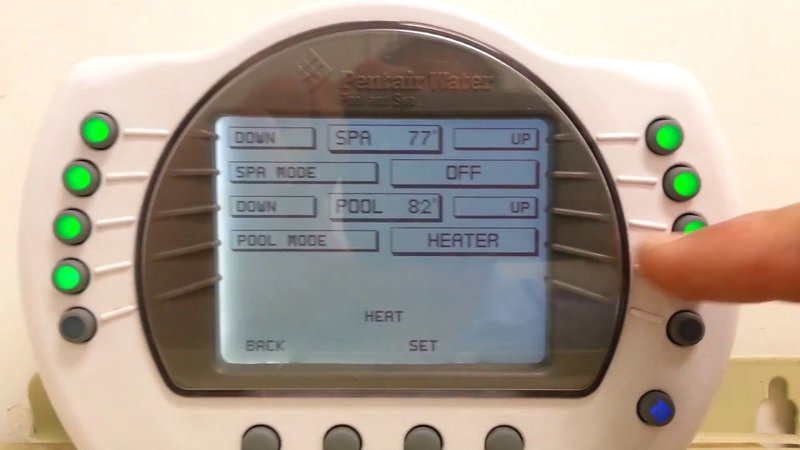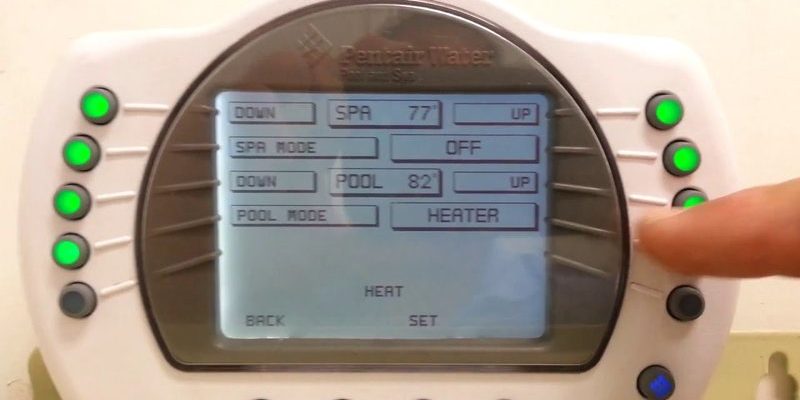
Here’s the thing: Pentair is one of the most popular pool equipment brands out there, and their remotes bring a ton of convenience to pool owners. Whether you’re using a handheld Pentair remote, a wall-mounted panel, or the slick Pentair mobile app, the ability to adjust your pool’s temperature remotely is a real game-changer. If you’re new to this kind of setup, don’t worry—I’ll walk you through the basics, show you how it all works, and help you avoid those classic “why isn’t it heating?” headaches.
Understanding Your Pentair Pool Remote: Types and Features
Alright, before you start pushing buttons, it helps to know exactly which Pentair remote you’re dealing with. Pentair offers a few options, but they all fall under two main categories: *physical remotes* and *app-based controls*. Each has its quirks, so let’s break them down.
The classic **Pentair wireless remote** (like the EasyTouch or IntelliTouch controller) is about the size of a TV remote, usually with a screen and a simple button layout. These remotes sync with the Pentair automation system installed near your pool equipment. Some folks love the tactile feedback—you click, you see the change, and boom, you’re done.
On the other hand, Pentair’s newer **mobile app** (called Pentair Home or ScreenLogic) lets you adjust everything right from your smartphone. The app offers a more visual interface, sometimes even letting you set schedules, get alerts, and monitor pool status from literally anywhere you’ve got WiFi or cell signal.
You might be wondering: is one better than the other? Honestly, it depends on how you like to control things. If you’re into buttons and direct access, the physical remote feels reliable. If you love using your phone for everything, the app’s flexibility will probably win you over. Both methods let you set temperature remotely—you just need to use the right steps for your setup.
How Remote Temperature Control Works With Pentair
Let me explain how all this magic happens behind the scenes. Your Pentair remote (or app) doesn’t heat the pool directly. Instead, it “talks” to your pool’s automation system—the brains in your pool’s control box. When you set a new temperature, the remote sends a signal (either wirelessly or via the internet) to the system, which then adjusts the heater accordingly.
Think of it as ordering takeout versus cooking: you give the command, and the system does the heavy lifting. If the pool’s heater is enabled and the system sync is working, you’ll see the temperature begin to change within a few minutes. But if the network is down, the remote’s battery is dead, or something’s out of sync, your command might get lost in the digital void.
Here’s why this matters: understanding this “chain of communication” helps you troubleshoot later. If your temperature isn’t adjusting, the issue might not be the remote itself—it could be a problem with code syncing, battery life, or even the heater’s settings. Keeping your remote paired and updated is key to smooth operation.
Step-By-Step: Setting Temperature Remotely With a Pentair Remote
Now, let’s get practical. Here’s a simple process to set your pool’s temperature remotely, whether you’re using a classic Pentair handheld remote or the Pentair Home app.
- Make sure your remote or app is paired and connected. If it’s your first time, follow the pairing instructions in your Pentair system’s manual. Most physical remotes sync with the main panel wirelessly, while the app requires WiFi setup and an access code from your control system.
- Power up your remote. For handheld remotes, double-check the battery. If the battery is low, remote responses can be sluggish or spotty. For the app, make sure your phone’s WiFi or data connection is solid.
- Navigate to the temperature settings. On the remote: scroll to the pool or spa heat option, usually with up/down arrow keys or a menu button. On the app: tap the temperature display or “Heater” icon—this will bring up your setpoint options.
- Adjust the temperature setpoint. Use the arrows or drag the digital slider to your desired temperature. Most pool heaters let you set a range, usually between 65°F and 104°F. Don’t forget to confirm your selection—some remotes require an extra “enter” or “save” tap.
- Wait for confirmation. Look for a confirmation beep (on remotes) or an in-app alert that the temperature is updating. The system might take a few minutes to relay this to your heater, especially if your WiFi is slow.
If everything’s synced and paired, your pool heater should kick in and gradually heat the water to your setpoint. If not, stick around—I’ll get into troubleshooting next.
Troubleshooting Common Pentair Remote Temperature Issues
Honestly, even high-tech pool systems have their “why won’t it work?” moments. Sometimes you tap the button, but the water just stays cold, or you get an annoying error message. It happens to everyone, so let’s walk through the usual suspects.
First off, check **battery status**. Low battery is a sneaky culprit for handheld remotes—if the display’s fading or the buttons are unresponsive, pop in a fresh set. For app users, make sure your phone isn’t in battery-saving mode, which can freeze up some connections.
Next, look at the **network connection**. If your remote isn’t syncing, try moving closer to your pool’s control panel. For the app, test your WiFi—sometimes a simple router reset fixes the issue. Errors like “Unable to communicate” usually mean the control center and remote aren’t paired or the network dropped out.
Also, don’t forget about **code mismatches**. When pairing a new device or after a system reset, you might need to enter a specific access code shown on the main Pentair panel. If you recently installed new equipment or updated the app, repeat the pairing steps to ensure everything’s talking to each other.
Lastly, **heater lockouts** or system safety settings can block remote temperature changes. If your heater’s in standby or the water’s already at the max temperature, the system won’t let you go higher. Double-check that the heater isn’t in maintenance mode or locked after a recent error.
If you’ve tried everything and it’s still not working, sometimes a full power cycle—shutting off the control system at the breaker for 30 seconds—can reset things. Think of it as the classic “turn it off and on again” for pools.
Comparing Pentair Remotes: Handheld vs. App-Based Controls
You might be wondering which remote is “best”—the old-school handheld or the slick new app. Honestly, there’s no universal winner here. It’s all about what fits your life and your comfort with gadgets.
- Handheld remotes are simple, sturdy, and less likely to get misplaced (since you’ll keep them with your pool stuff). They work independently of WiFi, so they’re a good backup if your internet is down. But if you lose the remote or the battery dies, you’re out of luck.
- App-based controls (like Pentair Home or ScreenLogic) are wildly convenient. You can set temperature from work, on vacation, or even before you get out of bed. The downside? If your WiFi has issues, or if the app crashes, you might miss the reliability of a physical button.
Some Pentair systems even let you use both—a remote for quick poolside tweaks, and the app for when you’re away. If you have kids or frequent guests, a dedicated remote keeps things simple. If you’re a techie or travel a lot, the app’s flexibility is unbeatable.
Setting Up Your Pentair Remote for First-Time Use
Let’s say you’ve just unboxed your Pentair remote, or you’re setting up the mobile app for the first time. Here’s how to get it all up and running:
- Check compatibility—make sure your pool’s control system (like EasyTouch, IntelliTouch, or IntelliCenter) supports remote/app control. Not every older Pentair setup does.
- Install fresh batteries (for handheld remotes) and follow the pairing process. Usually, this means pressing a “sync” or “pair” button on both the remote and the main panel until they connect. Don’t wander too far during this step—the first sync works best if you’re next to the main box.
- Download the Pentair Home or ScreenLogic app, then connect your control panel to your home WiFi (sometimes you’ll need an extra gateway or interface). The app will prompt you for a pairing code, which flashes on your pool’s control screen.
- Run an initial test by setting the temperature up or down a few degrees and making sure you see (or hear) a response from the heater. If it doesn’t work, double-check your pairing steps and network.
Honestly, the first setup can be a little fiddly—especially if your network isn’t rock-solid. But once you’ve paired everything and the code syncs correctly, it’s smooth sailing.
Remote Temperature Control: Why It’s So Useful
You might be asking, “Is this all just a luxury?” In a way, yes—but it’s also about comfort, efficiency, and peace of mind. Remote temperature control means you can:
- Warm up the pool before guests arrive, so no one’s shivering on the steps.
- Save energy by only heating when you need to—or turning things off from bed if you forgot.
- Respond to surprise weather changes (like a cold snap or heat wave) without running outside.
- Check in on the pool while you’re away, making sure nothing’s frozen or overheating during vacation.
It’s like having a smart thermostat for your living room, but for your backyard oasis. And in today’s world, that level of control just makes sense.
What to Do If Your Pentair Remote Stops Working
Sometimes, technology throws a curveball. Maybe your screen goes black, or your app just spins and spins. Here’s what I recommend if your Pentair pool remote refuses to play nice:
- Reset the remote: There’s usually a tiny reset pinhole on the back of handheld remotes—use a paperclip. For the app, force-close and reopen or reinstall it.
- Replace batteries: Obvious, but worth double-checking. Old batteries are the number one cause of weird, intermittent problems.
- Re-pair or re-sync the device: Sometimes the handshake between your remote and the pool’s main control box gets lost. Go through the pairing steps once more, entering the new code if prompted.
- Check for software updates: Both physical remotes and apps can benefit from a quick update—just like any other tech in your house.
If all else fails, don’t be shy about calling Pentair customer support. Their team can often walk you through a fix step-by-step, especially if you’re dealing with a rare code error or a unique setup.
Patience goes a long way with pool tech. Sometimes just taking a breath, resetting all the devices, and following each step slowly is the best strategy.
Wrapping Up: Enjoy Effortless Pool Comfort with Pentair Remotes
When you can set your pool’s temperature remotely using your Pentair remote, you’re not just playing with a gadget—you’re making your pool time smoother, more comfortable, and way more fun. Whether it’s a chilly morning swim or a surprise backyard party, controlling your pool’s heater from afar means one less thing to stress about.
Take your time with setup, keep batteries fresh, and remember that pairing and code syncing are your best friends. If something isn’t working, nine times out of ten it’s a small connection or battery hiccup—nothing a slow, careful reset can’t fix. At the end of the day, remote temperature control is all about enjoying your space exactly how you want it. So go ahead—turn up the heat, grab your towel, and make the most of your Pentair pool tech.
